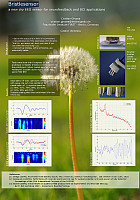
[Bristlesensors - Soft, Flexible Dry EEG Electrodes for Neurofeedback and BCI Applications., C.Grozea and C.Voinescu, 4th BCI Meeting, Monterey USA 2010] Background and Objective Dry EEG sensors are important for BCI technologies to gain wide-spread long-term use. The gel-based ones present inconveniences: gel is wet, it dries up and itches, requires hair washing afterwards, varying impedances and need for periodical recalibration. The existing dry EEG electrodes (typically arrays of metallic pins) have higher impedances than the wet ones, dependent on the level of pressure, and thus stable in time. This pressure makes them "bearable" to some (as opposed to "comfortable". Quoting one early designer and user of such pin arrays, "the thin pin arrays can hurt your skin if you use them (for) too long"[1]. Here a new dry EEG electrode is proposed, able to outperform electrically the existing dry electrodes while reducing the discomfort by distributing more uniformly and more flexibly the pressure on the skin of the scalp through the hair. The novelty consists in using conductive bristles instead of pins. Figure 1. (a) prototype 2; (b) Spectrum (log-amplitude for 2 to 45 Hz); (c) N100 AEP Methods The prototype1 uses metallic bristles from a soft wire brush. Its test consisted in contrasting the spectrum of the occipital signal (at Oz) recorded when 5 healthy male subjects had the eyes closed vs. eyes open (30s each) - using a wet reference electrode. The prototype2 (Fig.1a) is softer than the first one, as it has been obtained by coating thin polymer bristles with silver particles. With this prototype two paradigms have been tested on three healthy male subjects: (Fig.1c) the N100 auditory evoked potential, using the procedure described in [2,3], and again occipital alpha rhythm. Brainproducts Brainamp DC (set for 10MO input impedance) was used for the acquisition of the EEG signals in all 11 experiments. Results For prototype1, the impedances with the skin measured as low as 25 kO (vs. gel: 2kO; vs. pin-array electrode: 60kO), depending on the pressure level. Conditions' separability estimated with leave-one-out cross-validation of linear classification on spectra densities of 1 second long segments was: 96%, 71%, 79%, 89%, and 93%. For the coated polymer bristles prototype2, the impedance with the skin measured as low as 30kO for medium-to-high pressure (fully bearable) and typically 80kO for low, unobtrusive pressure on the scalp through the hairs. The spectrum for the best subject is shown in Fig.1b. The eyes open/eyes closed conditions separability was 92%, 80% and 79%. The t-test values for the N100 AEP effect were p=10^-4 for 20 trials and p=10^-8 for 100 trials. Discussion and Conclusions In this contribution, the results of using new, metallic and coated polymers bristles electrodes in the acquisition of the EEG in paradigms related to BCI have been reported. Those bristle-sensors outperform electrically the regular array of pins dry EEG electrodes, while providing better comfort to the subjects, creating the premises for longer term use in BCI applications. Authors' research on bristlesensors continues - there are already good preliminary results on auditory P300 ERP with two subjects. Keywords Dry electrode, EEG electrode, bristles, N100, ERP, alpha rhythm Disclaimer: The opinions expressed herein are the personal views of the authors. References [1] Ortega (2004), Active Electrode Building Guide, http://www.dcc.uchile.cl/~peortega/ae/ ; last checked on Jan 12th, 2010. [2] Grozea et al. (2009), Performance of novel dry electrode EEG cap for evoked potential and band-power activity detection. Proceedings of the 11th International Congress of the IUPESM. [3] Grozea (2009), Initial results on auditory P300 protocol with an experimental dry electrode EEG cap. Berlin BCI workshop 2009 "Advances in Neurotechnology"